Snakes are the most common reptiles worldwide, and nearly every person has witnessed them once in their lifetime. More than 3000 species of these limbless reptiles comprise various sizes, habitats, colors, and patterns. A particular snake’s distinct colors and patterns are the best way to identify its species from a distance. So here, we are back with a list of venomous and non-venomous black and yellow snakes.
Black snakes with yellow stripes are prevalent worldwide, especially in the US and India. Many people are generally curious to know whether these black and yellow snakes are venomous or not.
Therefore, we have also answered your query on which of these black and yellow snakes are venomous or non-venomous and how to identify them. But first, let’s jump onto the Black and Yellow snakes list.
Black and Yellow Snakes (List)
1) Paraguayan anaconda
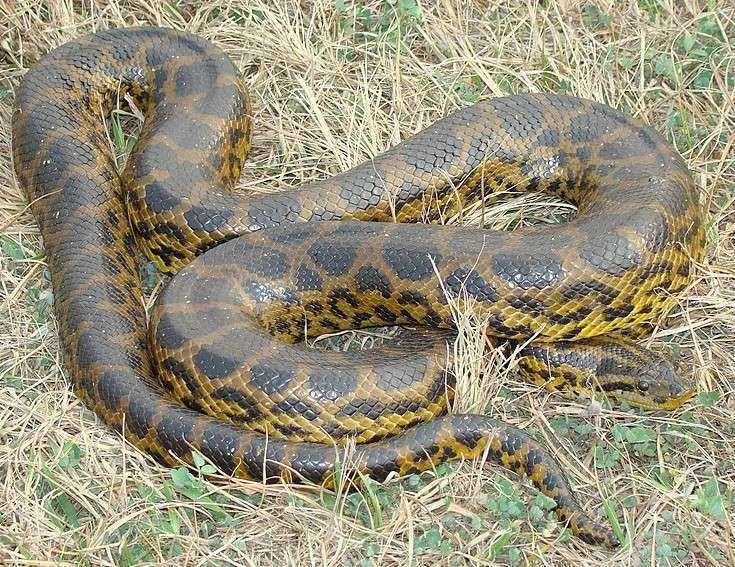
Paraguayan anaconda, also known as the Yellow anaconda, is an uncommon black and yellow snake. It is one of the largest snakes in the world, with sexual dimorphism, where females are larger than males.
Paraguayan anaconda has a yellow or golden tan body encrusted with black patterns uniformly distributed from head to tail.
Like other anacondas, these snakes predominately prefer aquatic habitats, including swamps, marshes, slow-moving rivers, ponds, and streams.
Paraguayan anacondas are non-venomous snakes that love to feed their prey alive. They subdue their prey by constriction.
Paraguayan anacondas mainly feed on aquatic and semi-aquatic species, including capybaras, beavers, fish, birds, and some medium-sized reptiles and amphibians. Many researchers believe in the observation of cannibalism in this species; however, it is not confirmed yet.
- Scientific name: Eunectes notaeus
- Size: 3.3 to 4.4m
- Location: Paraguay River in South America (including the Pantanal region in Bolivia, Paraguay, and western Brazil to northeastern Argentina)
2) Laotian Wolf Snake
The Laotian Wolf Snake is another uncommon black and yellow snake unknown to many people. These snakes are from the species of non-venomous colubrid snakes. Laotian Wolf Snakes kill or subdue their prey by constriction and then swallow them whole.
These snakes have dazzling black scales with whitish and yellowish crossbands evenly distributed throughout the body.
Laotian Wolf snakes are nocturnal means they track their prey with the help of pits that allows them to see infrared from hot-blooded animals at night.
Due to their shiny black, yellow, and white hues, many people consider them venomous, but they are neither venomous nor aggressive and generally reluctant to bite.
- Scientific name: Lycodon laoensis
- Size: 15-20 inches
- Location: India, Thailand, Laos, Vietnam, Cambodia, China (Yunnan), West Malaysia, and Northern Pakistan
3) Eastern Garter Snake
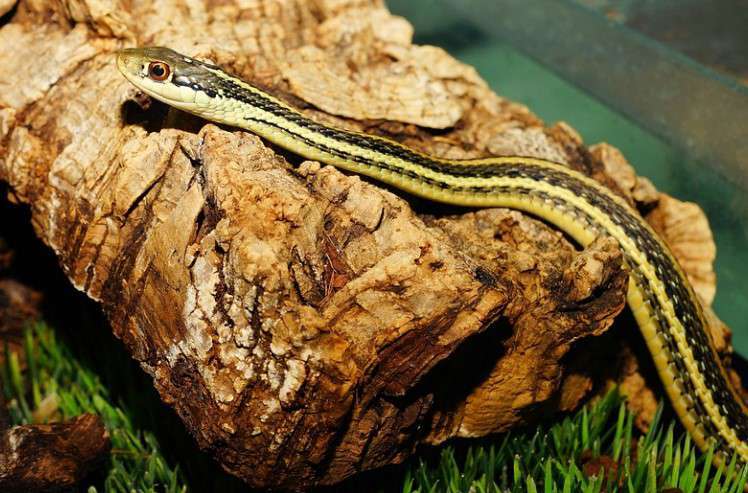
The next snake in the list of Black and Yellow snakes is Eastern Garter Snake. These snakes have sexual dimorphism, where females are larger than males.
Eastern Garter Snake has dusty black color with longitudinal yellowish stripes from the back side of the head to the tail.
Eastern Garter Snakes are ovoviviparous, producing eggs that develop within the body and give birth to young.
These small snakes have a variety of habitats, including shrubby fields, farmlands, dumps, near parks, rivers, lakes, and quarries where they can easily hide from predators.
Eastern Garter Snakes usually feed on small animals like toads, frogs, slugs, and worms. Also, they are mildly venomous. Their saliva comprises toxic to small animals, but it’s not dangerous for humans and may cause slight itching or burning.
- Scientific name: Thamnophis sirtalis sirtalis
- Size: 46-66cm
- Location: eastern North America
4) Timber rattlesnake

Timber Rattlesnake is one of the most dangerous snakes in North America. These snakes are highly venomous and the toxicity of their venom behaves differently depending on their geographic and ontogenetic variation.
The most common venom is neurotoxic, which directly attacks the nervous system, stopping nerve signals from getting through to the muscles and causing paralysis.
The common name of Timber rattlesnakes is canebrake rattlesnakes or banded rattlesnakes. These snakes are of the pit viper species in black and yellow color. As you can see in the image, they have a brownish-yellow background with a black and brown pattern all over their bodies.
Timber rattlesnakes mainly feed on small mammals, including rodents, frogs, small birds, and other small-sized mammals.
- Scientific name: Crotalus horridus
- Size: 91-152cm
- Location: the eastern United States, southern Minnesota, southern New Hampshire, south to East Texas, and North Florida
5) Wagler’s Pit Viper
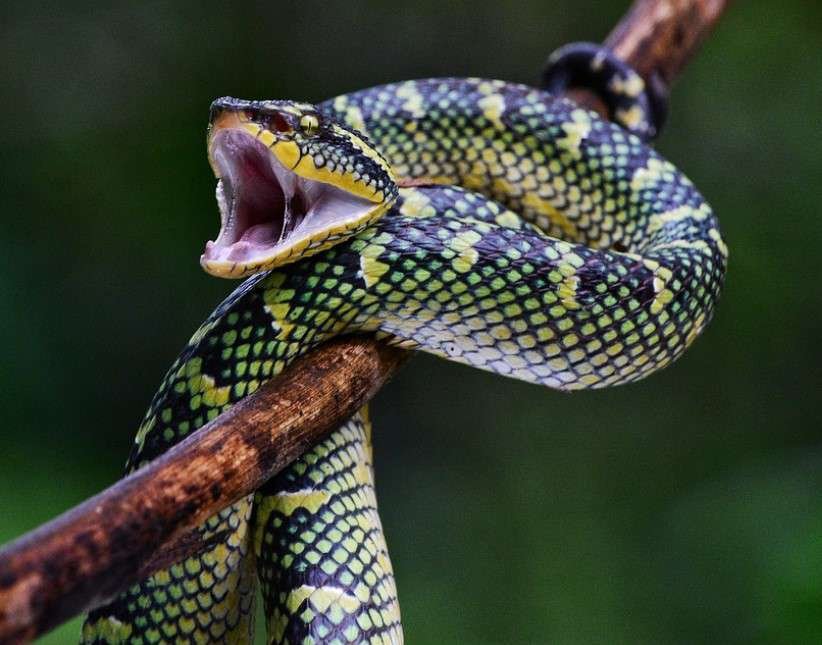
Another snake from a pit viper species is Wagler’s Pit Viper. Like Timber rattlesnakes, they are also highly venomous snakes with four novel peptides (Waglerins 1-4) that produce fatal respiratory paralysis.
Wagler’s Pit Vipers have a black body with beautiful yellow stripes parallelly distributed from head to tail. Males generally have thin green bodies.
The other common names of Wagler’s Pit Viper are temple pit viper, bamboo snake, temple snake, and speckled pit viper. The venom of these snakes is not as dangerous as Timber rattlesnakes but still toxic enough for local tissue destruction.
Wagler’s Pit Vipers’ natural habitat is forest, and they are nocturnal. It means they use their pit to sense the temperature of their prey, and it helps them to navigate in complete darkness.
Like other vipers, these snakes feed on rodents, lizards, birds, and other small snakes.
- Scientific name: Tropidolaemus wagleri
- Size: 75-105cm
- Location: southern Vietnam, southern Thailand, west Malaysia
6) Yellow Rat Snake

After mentioning back-to-back venomous snakes, let’s discuss non-venomous colubrid snakes. Yellow Rat Snakes are large snakes with a total body length of nearly 2.7m.
These snakes are yellow, with black stripes unevenly distributed throughout the body. As displayed in the image, the Yellow Rat Snake has a yellow snout and a black stripe behind their eyes. These are two primary identification marks of these snakes.
Yellow Rat Snakes are commonly known as tiger rat snakes and chicken snakes. They love warmer habitats. The average lifespan of Yellow Rat Snakes is nearly 17 to 20 years. Like other nonvenomous snakes, they feed on rodents, bats, lizards, and other small animals. In short, rat snakes eat any relatively smaller prey.
- Scientific name: Spilotes pullatus
- Size: 2-2.7m
- Location: Southern Mexico, Central America, northern and central South America, Trinidad and Tobago
7) Banded Krait
One of the most venomous snakes on the list is the Banded Krait. These snakes are the species of elapid snake that are dangerous to humans. The venom of Banded Kraits contains neurotoxins, and they deliver nearly 20-114mg of venom in a bite. The significant effects are vomiting, pain, diarrhea, and dizziness. And if the amount is large, it leads to respiratory failure and death.
Banded Krait has uniformly distributed alternative black and yellow crossbands. These are giant snakes and can attain a total length of 2.25m. They have shiny scales and can easily be identified from a distance.
Banded Krait loves to feed on other smaller snakes, including rat snakes, Cat snakes, Rainbow snakes, sunbeam snakes, etc. Their other diet options are frogs, fish, and eggs.
- Scientific name: Bungarus fasciatus
- Size: 2-2.7m
- Location: Central India through Bangladesh, Myanmar, Cambodia, Thailand, Laos, Vietnam, and southern China
8) Ring-necked Snake
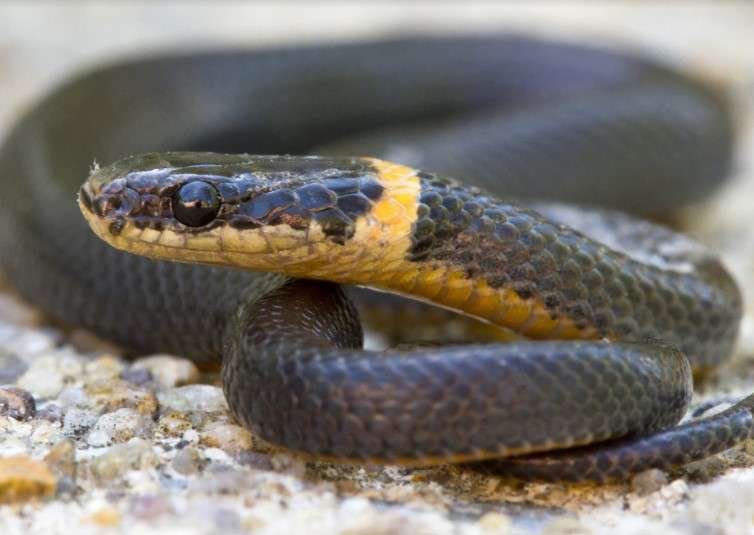
Ring-necked snakes are non-venomous black snakes with yellow rings around their neck. These snakes can be found with body and ring color depending on their habitat.
But here we are, mentioning only ring-necked snakes having a black body with a yellow ring. These snakes are small terrestrial harmless snakes. Like many other snakes, Ring-necked snakes are nocturnal and mainly dependent on their pits to sense their prey.
They are non-venomous, so they eliminate their prey by constriction. As you can see in the image attached above, ring-necked snakes have black upperparts, and their bellies are yellow. These snakes eat small animals like lizards, worms, frogs, toads, etc.
- Scientific name: Diadophis punctatus
- Size: 21-36cm
- Location: southern Canada, Florida, Pacific coast
9) Eastern Hognose Snake
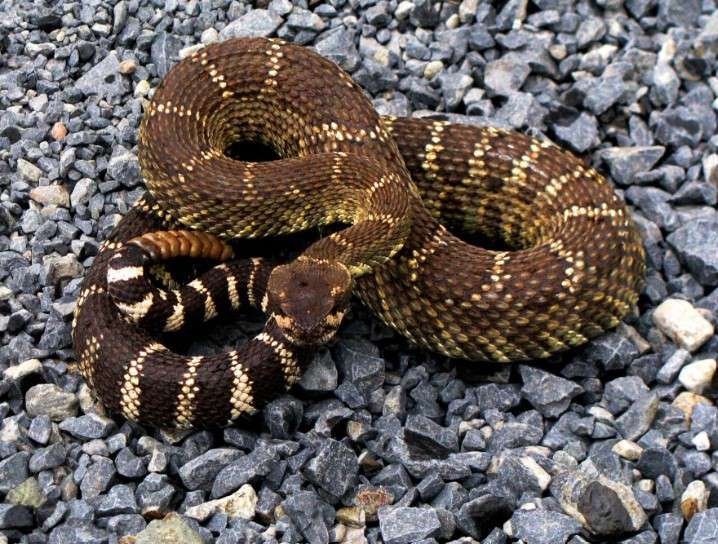
Next one in the list, we have a mildly venomous snake, Eastern Hognose Snake. These snakes are brown or black in color with yellow stripes from neck to tail. They have too many familiar names; some are spreading adder, black adder, black blowing viper, buckwheat-nose snake, and many others.
Unlike other venomous snakes, the venom of these snakes is not poisonous to humans and results in local swelling. But it’s enough to take down small amphibians.
Eastern Hognose snakes can be found in many colors and patterns depending on their habitat. They have a lower life span than other snakes, i.e., only 12 years.
Eastern Hognose Snakes love to live in pine-forest and forest edges and feed on small amphibians like frogs and salamanders.
- Scientific name: Heterodon platirhinos
- Size: 28-41 inches
- Location: North America
10) Sonoran Gopher Snake
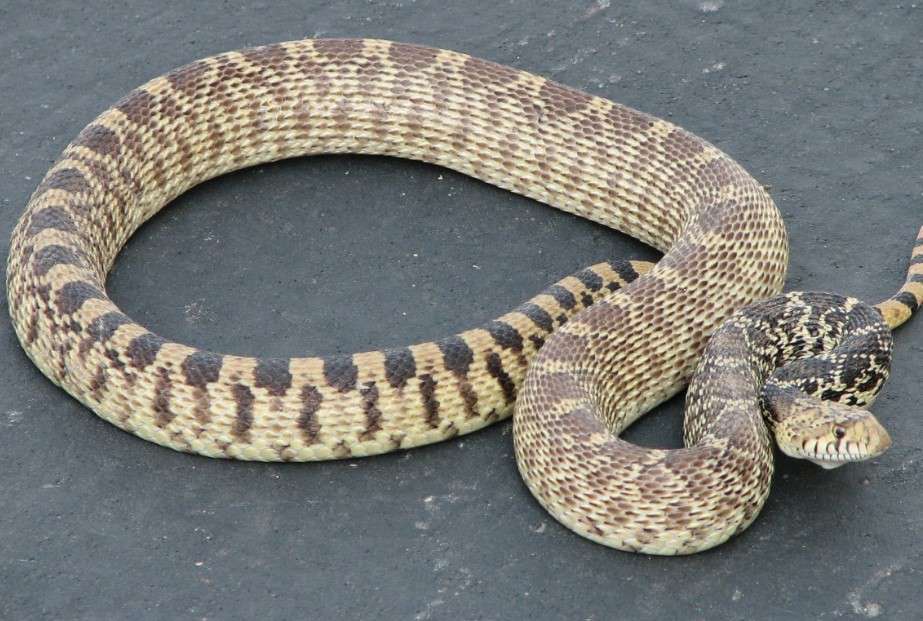
The Sonoran gopher snake is a colubrid snake primarily found in the southwestern region of the United States. It is a non-venomous snake with a total length of 6 ft.
The highest recorded length is around 7 ft. The dorsal part of the abdomen has brownish patches, and the tail has a black color. Its habitat is predominantly the Sonoran Desert and feeds on small rodents, hence the name gopher snake.
- Scientific name: Pituophis catenifer affinis
- Size: 4.17–6.00 ft
- Location: Southwestern United States to southeastern California, Arizona, and south into the northern states of Mexico
11) Saharan horned viper
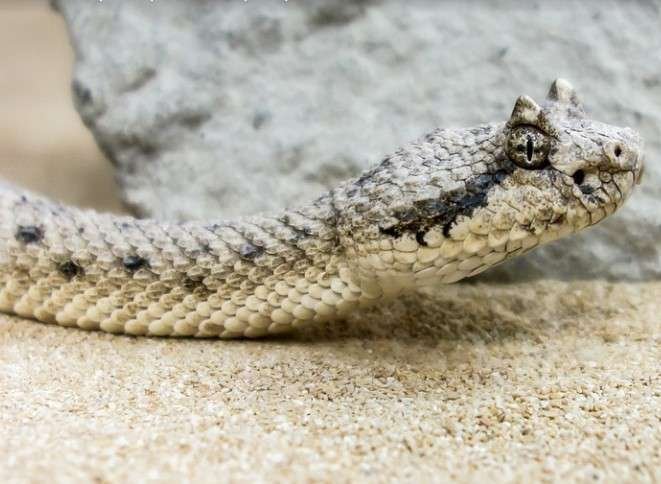
The Saharan horned viper or the desert horned viper is a native species of the viper family and is found in the deserts of Northern Africa and some parts of the Arabian Peninsula as well. Its characteristic feature is that it has a pair of horns on its head.
The total length of a Saharan horned viper is up to 24 inches, and females are larger than males. It has a varied color pattern, including yellowish, brownish, pinkish, pale grey, etc.
It has a color camouflage of desert that helps to hide it from its prey. Saharan horned viper prefers dry, sandy soil and desert area as their habitat and is sometimes found near oases as well. Its venom can cause swelling, hemorrhage, nausea, necrosis, vomiting, etc., in human beings with a lethal dose of 40- 50 mg.
- Scientific name: Cerastes cerastes
- Size: 12–24 inches
- Location: Iraq, Syria, Saudi Arabia, Yemen, Jordan, Israel and Kuwait, and some parts of North Africa
12) Yellow-Bellied Sea Snake
The yellow-bellied sea snake is a venomous snake belonging to the sea snakes Hydrophiinae subfamily. These sea snake species have a bicolor pattern of yellow and black bodies found in tropical oceanic waters worldwide, making them exclusively differentiable.
The ventral part is totally of yellow in color, while the dorsal side is black with small yellow blotches around its tail. The yellow-bellied snake is one of the most popularly found snakes worldwide.
They breed in warm water and are ovoviviparous. Its venom is highly dangerous and can cause myoglobinuria, neuromuscular damage, and renal damage. As it is a sea snake species, it eats only small fish.
- Scientific name: Hydrophis platurus
- Size: 28-35 inches
- Location: Tropical oceanic waters
13) Eastern Ribbon Snake

The eastern ribbon snake is a non-venomous colubrid snake that belongs to the subfamily Natricinae. It is a garter snake that is found in eastern areas of North America and has an average length of 35 inches.
The habitat of ribbon snakes includes wet areas such as lakes, streams, ponds, and marshes. It feeds on cold-blooded species that primarily live around wet regions.
Eastern Ribbon snake has a dark brown or black body with yellow strips on both the dorsal and ventral side of the abdomen. Females are thicker than males ones. As it is a non-venomous colubrid snake, these snakes aren’t threatening human lives.
- Scientific name: Thamnophis saurita
- Size: 16 to 35 inches
- Location: Eastern North America
14) Golden tree Snake
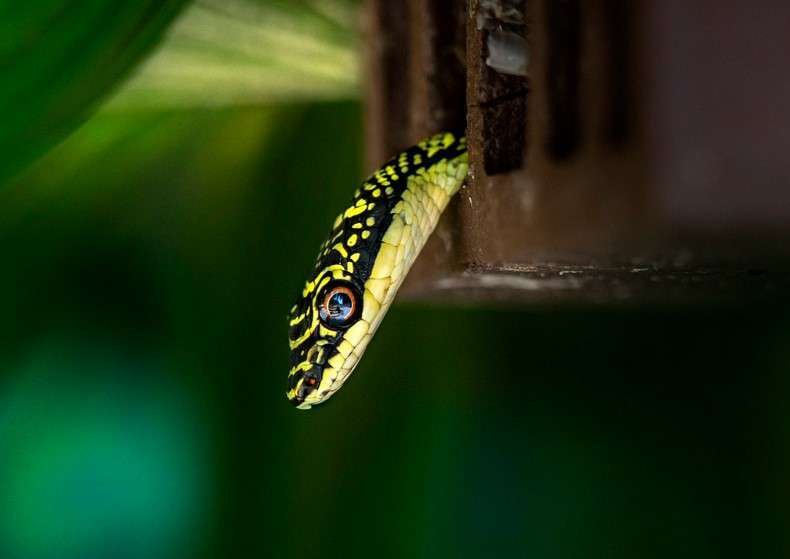
The common name of the Golden Tree Snake is Ornate flying Snake or Golden flying Snake. These colubrid snakes are natives of Southeast and South Asia. The golden tree snakes are capable of gliding and also are rear-fanged snakes.
It has a yellow-black color pattern all over the body but is usually green in color. They have an average length of 0.38 to 4.27 ft. and mainly feed on frogs, geckos, small birds, etc.
It comes under the category of one of the most popular pet snakes worldwide. The golden tree snakes are not hazardous to human beings; instead, they’re to be used for medicinal purposes by us.
- Scientific name: Chrysopelea ornata
- Size: 0.38 to 4.27 ft
- Location: India (North Bengal), Bangladesh, Sri Lanka, Nepal, Myanmar, Thailand, Western Malaysia, Laos, Cambodia, Vietnam, China (Hong Kong, Hainan, Yunnan), and Singapore
15) Tiger snake
Tiger Snakes are the common venomous snake across southern Australia. Their venom comprises powerful neurotoxins, coagulants, haemolysins, and myotoxins that can cause intense pain, numbness, and sweating. High doses can lead to failure in the respiratory system and paralysis.
Depending on the habitat, Tiger snakes have distinct common names, colors, and patterns. Some are the common tiger snake, western tiger snake, and Chappell Island tiger snake. Here, we are discussing on common tiger snake.
These snakes mainly feed on small animals, including frogs, birds, rodents, etc.
- Scientific name: Notechis scutatus
- Size: 0.9-1.8m
- Location: Southern Australia
16) Plains Garter Snake
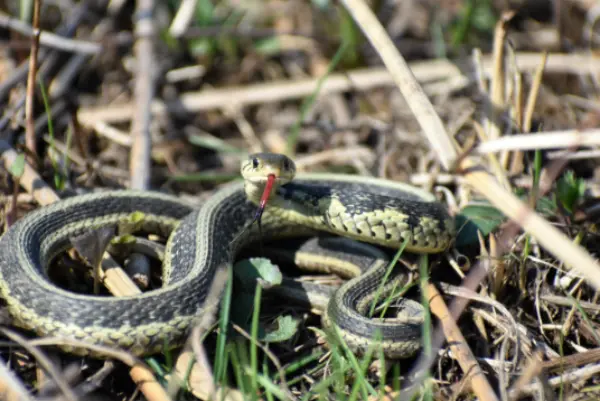
The Plains Garter Snake is a medium-sized snake that is typically 15 to 28 inches long. It has a grayish-brown or greenish background color with three yellow, orange, or off-white stripes running down its back with black patterns.
The stripes are usually wider on the head and neck, and they narrow as they get closer to the tail. The snake also has black bars on its lips and a gray-green belly with small dark spots.
- Scientific name: Thamnophis radix
- Size: 15 to 28 inches long
- Location: native to the United States and Canada
17) Juvenile King Cobra

Juvenile King Cobras are black with chevron-shaped white, yellow, or buff bars that point towards the head. They are typically 37.5 to 58.5 centimeters (14.8 to 23.0 inches) long and weigh 9 to 38 grams (0.32 to 1.34 ounces).
Their venom is as potent as that of the adults. They may be brightly marked, but these colours often fade as they mature. They are alert and nervous, being highly aggressive if disturbed.
- Scientific name: Ophiophagus hannah
- Size: 3 to 3.6 meters
- Location: northern India, east to southern China, including Hong Kong and Hainan; south throughout the Malay Peninsula and east to western Indonesia and the Philippines
Other List
-
18) Scarlet Kingsnake
-
19) Striped Racer
-
20) Western Shovelnose Snake
-
21) Eastern (or Harlequin) Coral Snake
-
22) Rosy boa
-
23) Salt Marsh Snake (Nerodia clarkii)
-
24) Amethystine Python
-
25) Banded Egyptian cobra
-
26) Western Diamondback Rattlesnake
-
27) Mexican Short-tailed Snake
-
28) Military ground snake
-
29) Terrestrial Snail Sucker
-
30) Yellow-Bellied Liophis
-
31) Black-tailed rattlesnake
-
32) Western ribbon snake
-
33) Arizona Black Rattlesnake
-
34) Resplendent Desert Shovel-Nosed Snake
-
35) Eastern Foxsnake
-
36) Lined snake
-
37) California Kingsnake
-
38) Western patch-nosed snake
-
39) Striped Whipsnake
-
40) Eastern Patch-Nosed Snake
-
41) Pine Snake
-
42) Speckled Kingsnake
-
43) Cottonmouth
-
44) Perrotet’s mountain snake
-
45) Mizo rain snake
-
46) Inland Taipan
-
47) Beddome’s cat snake
Here we conclude our article. We hope you like this post. Below we have discussed some Frequently Asked Questions related to snakes that are black and yellow. So, let’s go through it.
Frequently Asked Questions:
Q1. Are Black and Yellow snakes dangerous?
Ans. Not all Black and Yellow snakes are dangerous, but some of them are. Like yellow rat snakes are non-venomous, and on the other hand, Banded Krait is dangerous to humans. Identifying the particular species of black and yellow snake is safe before reaching them.
Q2. Which Black and Yellow snakes are venomous?
Ans. Banded Krait, Wagler’s Pit Viper, Timber rattlesnake, and Eastern Garter Snake are some venomous snakes.
Also Read:

Meet Abhidept (nickname Monty), the visionary founder of How It See, being an engineering student, he’s fueled by an insatiable curiosity about the world around him. He is captivated by an eclectic correlation between animal groups, science, and nature, and this fascination drives his quest for understanding.
After completing his degree, he’s set on a mission to delve deep into the realm of nature, accumulating knowledge to share with you through his writing. In the meantime, he loves to watch anime and read anime.
